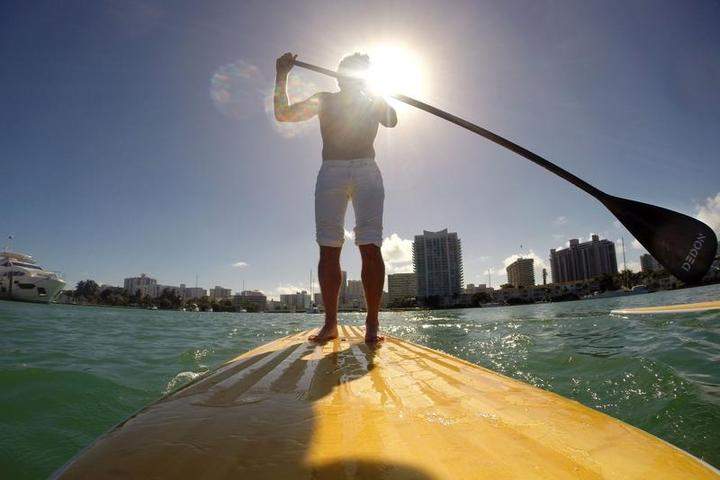BRECKENRIDGE, Colo. – Merrill Mann had always been intrigued when she saw people on standup paddleboards tooling around on area lakes, so when she found a coupon for a rental, she decided to give it a try.

Now she’s hooked.
“I loved it the first time I tried it,” said Mann, who rides on lakes near her home in Avon. “Anything with the outdoors, being on the water, it’s very serene yet you’re getting a workout. You’re exercising and out in the sun.”
Standup paddleboarding has exploded in popularity the past few years. A sort of combination between surfing and kayaking, it has become a hit on oceans, lakes and rivers across the United States and beyond.

According to a 2013 Outdoor Foundation recreation report, standup paddleboarding was the most popular outdoor activity for first-time participants, garnering 56 per cent of the newbies among all outdoor activities last year.
The appeal is simple: It’s relatively easy, available to a wide range of ages and can be done just about anywhere there’s a body of water.

Get daily National news
“I think the reason it’s blowing up so much is there’s no limitations,” said RJ Murray, co-owner of Three Brothers Boards in Daytona Beach, Florida.
“As long as you have a body of water, it doesn’t matter where you are. People who lived away from the ocean and wanted to be in that environment never really had that option before paddleboarding.”
Standup paddleboarding is not new.
The ancient Hawaiians were believed to use it as transportation between islands and for fishing, while fishermen from Asia to South America have used forms of standup paddleboarding while working their catch.
The recent rise in popularity started with surfers and carried on with tourists in beach towns who then took the idea back to where they live.
Now, standup paddleboarders can be found cruising along the shore on just about every coast, across mountain lakes, racing down rivers and even participating in group yoga classes atop their boards.
“When I first heard people wanted to do yoga classes on paddleboards, I was like, ‘You’ve got to be kidding me,”‘ said Murray, who started Three Brothers with his brother Justin in 2009. (A third brother, Jason, died earlier that year.) “People are getting really creative with it. I can’t imagine where it will be four years from now.”
The equipment certainly has changed.
Little more than modified surfboards just a few years ago, boards now are specifically designed for standup paddling, averaging 10 to 12 feet in length and contoured for easy balancing. Ocean boards are typically made of the same materials as surfboards, while boards used on lakes and rivers can be made of inflatable material used for river rafts or injected plastic like kayaks.
Optimal size for the paddle is 8 to 10 inches longer than the paddler, to give them leverage.
“The boards have gotten more complex, the competition stiffer,” Murray said. “In four years, the sport has done a 180.”
The changes have added to the popularity.
Because the boards have become so sturdy, standup paddleboarding has become a sport nearly anyone can handle, not just surfers or swimmers.
Set up with the right size board and calm water conditions, most first-timers only need about 10 minutes to feel comfortable and start paddling away. It gets a bit more difficult when there are waves or a current, but remains accessible to people from 7 to 77, according to Murray.
“You pretty much get up at your own pace,” said Mary Hoffius, who lives in Breckenridge and has been standup paddleboarding for three years. “You start off on your knees and you stand up. The boards are really sturdy now. It’s actually hard to fall off on a still body of water. It took me no time.”
Like any sport, standup paddleboarders have picked up the pace within the sport, pushing the boundaries to new, adrenaline-fuelling levels.
Races have cropped up across the country. Paddlers also have joined surfers in hanging 10, using their paddles for added speed while riding the waves into shore.
But most riders do it just for the enjoyment of being out on the water and in the sun, enjoying the scenery while getting a decent upper-body and core workout. “It’s not like you’re racing down the side of a mountain on a mountain bike and all the danger that goes along with that, so it’s a more low-key activity,” Mann said.

Comments